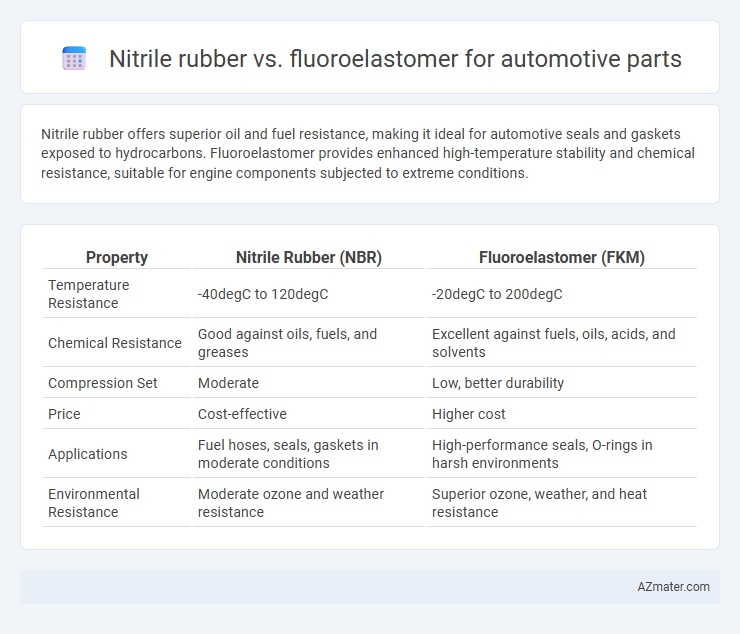Nitrile rubber offers superior oil and fuel resistance, making it ideal for automotive seals and gaskets exposed to hydrocarbons. Fluoroelastomer provides enhanced high-temperature stability and chemical resistance, suitable for engine components subjected to extreme conditions.
Table of Comparison
| Property | Nitrile Rubber (NBR) | Fluoroelastomer (FKM) |
|---|---|---|
| Temperature Resistance | -40degC to 120degC | -20degC to 200degC |
| Chemical Resistance | Good against oils, fuels, and greases | Excellent against fuels, oils, acids, and solvents |
| Compression Set | Moderate | Low, better durability |
| Price | Cost-effective | Higher cost |
| Applications | Fuel hoses, seals, gaskets in moderate conditions | High-performance seals, O-rings in harsh environments |
| Environmental Resistance | Moderate ozone and weather resistance | Superior ozone, weather, and heat resistance |
Introduction to Nitrile Rubber and Fluoroelastomer
Nitrile rubber (NBR) is a synthetic elastomer known for its excellent resistance to oils, fuels, and other petroleum-based fluids, making it a popular choice in automotive seals and gaskets. Fluoroelastomer (FKM), recognized for its superior heat, chemical, and weather resistance, is commonly used in high-performance automotive components exposed to extreme conditions. Both materials offer distinct advantages, with NBR providing cost-effective durability and FKM delivering enhanced longevity in demanding environments.
Chemical Composition and Structure Differences
Nitrile rubber (NBR) consists primarily of acrylonitrile and butadiene, providing excellent resistance to petroleum-based oils and fuels due to its polar nitrile groups. Fluoroelastomers (FKM) have a copolymer structure based on vinylidene fluoride and hexafluoropropylene, offering superior chemical resistance and thermal stability from their strong carbon-fluorine bonds. The distinct molecular structures result in NBR excelling in fuel and oil applications, while FKM withstands aggressive chemicals and higher temperatures, making it ideal for harsh automotive environments.
Temperature Resistance Comparison
Nitrile rubber exhibits effective temperature resistance ranging from -40degC to 120degC, making it suitable for many automotive applications involving moderate heat exposure. Fluoroelastomer outperforms nitrile rubber with a broader temperature tolerance, functioning efficiently between -26degC and 205degC, ideal for high-performance engine components and fuel system seals. The enhanced thermal stability of fluoroelastomers ensures superior durability and sealing performance in extreme temperature environments within automotive systems.
Oil and Chemical Resistance Capabilities
Nitrile rubber (NBR) offers excellent resistance to petroleum-based oils, fuels, and many chemicals, making it suitable for automotive seals, gaskets, and hoses exposed to hydraulic fluids and engine oils. Fluoroelastomer (FKM), known for superior chemical and temperature resistance, withstands aggressive automotive chemicals, including synthetic oils, fuels, and brake fluids, exceeding NBR's performance in harsh environments. Fluoroelastomer is preferred for high-performance automotive parts requiring long-lasting durability against a wider range of oils and aggressive chemicals.
Mechanical Properties and Durability
Nitrile rubber exhibits excellent resistance to oil, fuel, and abrasion, making it suitable for automotive seals and gaskets where flexibility and tensile strength are critical. Fluoroelastomers offer superior heat resistance, chemical stability, and aging performance, maintaining mechanical integrity in high-temperature environments such as engine compartments. The durability of fluoroelastomers surpasses nitrile rubber in harsh conditions, delivering enhanced resistance to oxidation, ozone, and fuel additives, thereby extending the lifespan of automotive components.
Cost Analysis for Automotive Applications
Nitrile rubber (NBR) offers a cost-effective solution for automotive applications due to its lower raw material and processing costs compared to fluoroelastomers (FKM), making it ideal for seals, gaskets, and hoses exposed to moderate temperatures and petroleum-based oils. Fluoroelastomers provide superior chemical resistance, high-temperature stability up to 200-250degC, and excellent durability in harsh environments, justifying their higher price in critical engine components and fuel system applications. Cost analysis reveals that while NBR reduces upfront expenses by 30-50%, FKM's longevity and performance in aggressive conditions minimize maintenance and replacement costs, resulting in better total cost of ownership for high-demand automotive parts.
Common Automotive Parts Using Each Material
Nitrile rubber (NBR) is widely used in automotive parts such as fuel system seals, O-rings, and hoses due to its excellent resistance to petroleum-based oils and fuels. Fluoroelastomer (FKM), known for its superior high-temperature and chemical resistance, is commonly found in fuel injector seals, turbocharger hoses, and coolant system gaskets. Both materials serve critical roles in enhancing vehicle durability and performance under varied operational conditions.
Environmental and Regulatory Considerations
Nitrile rubber (NBR) offers excellent resistance to oils and fuels but poses challenges in environmental compliance due to its lower thermal stability and potential for hazardous emissions during degradation. Fluoroelastomers (FKM) excel in meeting stringent automotive environmental regulations by providing superior chemical resistance, thermal stability, and reduced volatile organic compound (VOC) emissions. Regulatory frameworks such as REACH and EPA standards increasingly favor FKM for automotive parts demanding durability and eco-friendly attributes.
Maintenance and Longevity in Automotive Use
Nitrile rubber offers excellent resistance to petroleum-based oils and fuels, making it a cost-effective choice for automotive seals and gaskets with moderate maintenance requirements. Fluoroelastomer excels in high-temperature stability and chemical resistance, significantly extending the lifespan of automotive parts exposed to harsh engine fluids and extreme conditions. The superior durability and low degradation rate of fluoroelastomer reduce maintenance frequency and improve overall vehicle reliability.
Choosing the Right Material for Automotive Parts
Nitrile rubber delivers excellent resistance to petroleum-based oils, making it ideal for seals and gaskets exposed to fuel and lubricants in automotive engines. Fluoroelastomer offers superior heat, chemical, and ozone resistance, suitable for high-temperature environments such as fuel system components and turbocharger seals. Selecting the right material depends on specific application conditions, balancing cost, temperature tolerance, and chemical compatibility for optimal automotive part performance.

Infographic: Nitrile rubber vs Fluoroelastomer for Automotive part
 azmater.com
azmater.com